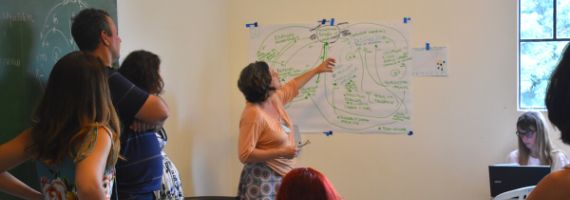SALURBAL: Systems Thinking for Urban Health
SALURBAL recognizes that cities are complex systems.
The SALURBAL team uses systems approaches to gain insight into the dynamic relationships between the urban environment, health, and environmental impact.
These approaches help researchers to identify the potential and likely impacts of urban policies under different conditions.
FOOD AND TRANSPORT SYSTEMS IN LATIN AMERICAN CITIES
SALURBAL researchers focus their systems research on two specific areas: urban food systems and urban transportation systems.
Food access and policies in cities are also interconnected with many factors that influence health, equity, and sustainability:
- Access and promotion: Food security, cost of different food items, access to healthy foods, advertising of ultra-processed foods and sugar-sweetened beverages
- Environment: Carbon footprint of certain food products
- Social and behavioral factors: Convenience of packaged foods, time needed to prepare food at home
- Diet and health: Hypertension, diabetes, cancer, overweight and obesity
Transportation options in cities are interconnected with many factors that influence health, equity, and sustainability:
- Environment: Air pollution, carbon emissions, urban sprawl
- Social and equity factors: Commute time, access to jobs and services, cost of commuting, crowding, stress, security, and safety
- Health: Physical activity, inhalation of air pollution, injury, violence
Changes to both food and transport systems in cities can have impacts in the short-, medium-, and long-term, making them ideal subjects for systems modeling.

PARTICIPATORY SYSTEMS MODEL BUILDING
As a first step to understanding food and transport systems in Latin American cities, SALURBAL held a series of participatory workshops.
Three workshops, held in Peru, Brazil, and Guatemala in 2017 and 2018, engaged more than 60 stakeholders from a variety of sectors across the region. They were asked to contribute their thoughts on how food and transport systems work, and how these systems are connected.
The outcomes of these workshops were analyzed to provide insight into both how these urban systems might function in cities in Latin America, as well as insight into how these stakeholders understand and envision these systems.
AGENT-BASED MODELING
SALURBAL researchers are developing two “agent-based models” to understand how different policies might impact health and the environment in a simulated real-world scenario.
Through agent-based modeling, researchers are constructing virtual worlds where “agents” –virtual urban citizens –can make choices and take action depending on their environment and characteristics that researchers assign to them.
A food-focused agent-based model has been designed to mimic an urban environment similar to Mexico City, where the agents –in this case, women who are responsible for food purchases for their families –are observed as they make food purchasing choices. Within the model, researchers can adjust:
- Taxation of ultra-processed foods
- The amount of advertising of ultra-processed foods the women are exposed to
- Whether or not ultra-processed foods have warning labels
Researchers can adjust levels of taxation, advertising, and labeling, and then observe the amount of ultra-processed foods the women purchase over time under different scenarios.
A transportation-focused agent-based model has been designed to mimic an urban environment similar to Bogotá, Colombia, where the agents –in this case, commuters –make choices about how they commute within the city each day. Within the model, researchers can adjust:
- Access to mass transit and active transportation options
- Regulations and taxes designed to limit car use
- Implementation of crime reduction interventions
Researchers can adjust these aspects of the model, then observe the commuting choices of city residents under different scenarios. This can help them to make recommendations to policymakers about the conditions under which air pollution, carbon emissions, and crime can be minimized while mass transit use and physical activity can be maximized.
TIMELINE
